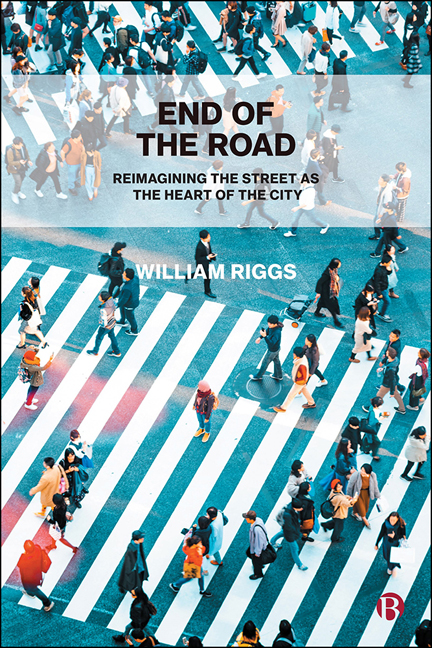Book contents
- Frontmatter
- Dedication
- Contents
- List of Figures and Tables
- Acknowledgments
- 1 Introduction
- 2 A Recent History of the Street
- 3 The Street for Transport
- 4 The Street as Economic Space
- 5 The Street as Social Space
- 6 The Street as Cultural Space
- 7 The Street as a Natural Space
- 8 Challenges to Ending the Road
- 9 Beyond Streets: Integrating Behavior
- 10 A Window into the Future: New Vehicles, New Streets
- 11 A Call to Action: Streets as the Heart of the City
- Appendix
- Notes
- References
- Index
2 - A Recent History of the Street
Published online by Cambridge University Press: 12 October 2022
- Frontmatter
- Dedication
- Contents
- List of Figures and Tables
- Acknowledgments
- 1 Introduction
- 2 A Recent History of the Street
- 3 The Street for Transport
- 4 The Street as Economic Space
- 5 The Street as Social Space
- 6 The Street as Cultural Space
- 7 The Street as a Natural Space
- 8 Challenges to Ending the Road
- 9 Beyond Streets: Integrating Behavior
- 10 A Window into the Future: New Vehicles, New Streets
- 11 A Call to Action: Streets as the Heart of the City
- Appendix
- Notes
- References
- Index
Summary
She had always been fond of history, and here was history in the stones of the street and the atoms of the sunshine. (Henry James, 1917, p 301)
If we are to better understand how the street can be shaped for livability and human interaction, it is helpful to start with a basic understanding of how streets have evolved over the past few centuries. In that sense, the first thing that may come to mind when considering this history might be the cart paths that facilitated trade in medieval Europe and the Middle East or perhaps the dusty road outside a saloon from a glamorized American Western movie. While there may be lessons to learn from these visions of the street, the origins of the modern street stem largely from the urbanization and industrialization following the industrial revolution and post-war reconstruction periods (Boyer, 1986). Given that, this discussion begins at the Industrial Revolution in the early 19th century and the creation of the modern engineered street.
This beginning does not discount the many different forms that a road can take, and I fully realize that the experience of an organized, paved, modern road is not necessarily one that all can say they have. When I was a boy growing up in a rural and poor community near Louisville, Kentucky, seeing an unpaved dirt or gravel road was not uncommon, and this kind of “un-engineered” street is still common in many places around the globe. I have strong memories of walking down dirt roads surrounded on both sides by beautiful fields of corn standing four to six feet high and extending far into the horizon until they met the hills of the Ohio River Valley.
As discussed earlier, after college, I had the opportunity to teach in a village on the outskirts of Arusha, Tanzania, and had a similar experience to what I had already had in Kentucky. Each day my friend Nathaniel and I walked from the house that we had rented to the school where we were working on a dirt street that was flanked by fields of corn.
- Type
- Chapter
- Information
- End of the RoadReimagining the Street as the Heart of the City, pp. 16 - 27Publisher: Bristol University PressPrint publication year: 2022

